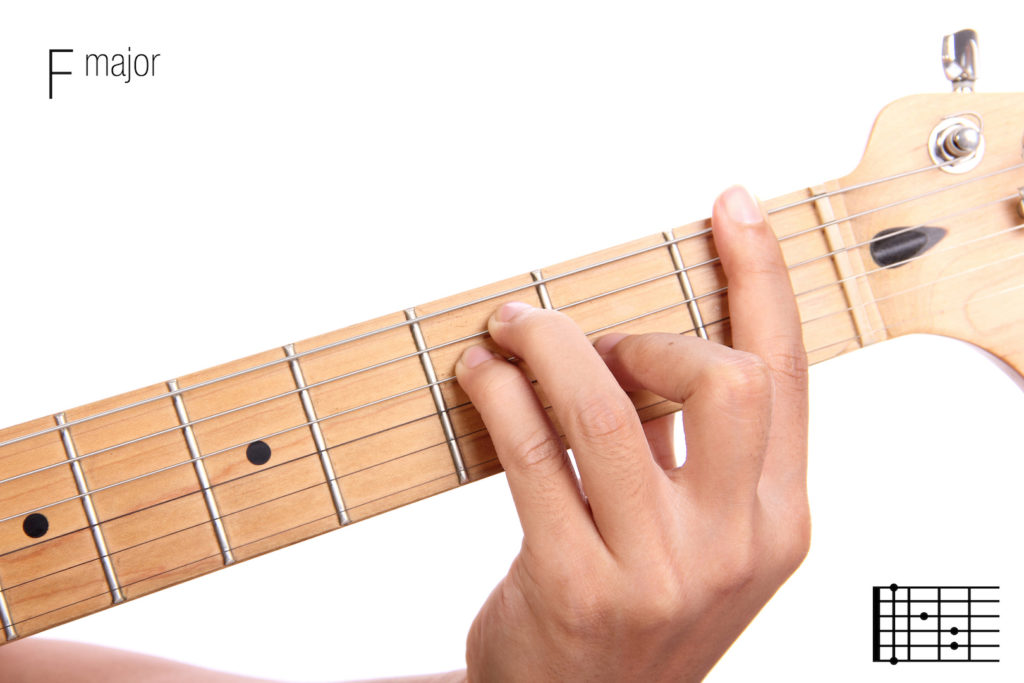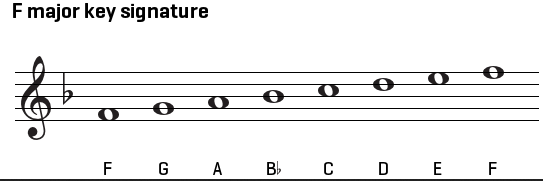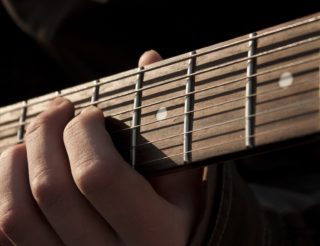F Chord on Guitar: History, Relevance, Chord Shapes, Major Scale, & Songs in the Key of F
Author: Wanda Waterman

Welcome to yet another article in our “Chord of the Week” series, in which we share a new guitar chord each week, exploring its history, its relevance, how it’s played on the guitar, its major scale, some common chord progressions, and a few popular songs in the key of the chord.
“Think of the key of F as your naively optimistic friend, the one you turn to when you need a boost, a positive outlook, or just some good vibrations.”
This week we’re bringing you the F Major chord, the root chord of the key of F. The notes of the f chord are F, A, and C, which we’ll explain further down below….
Table of Contents
F Major History Lesson: Your Guitar’s Friendly Country Cousin

Some of the best loved classical compositions were written in the key of F Major, for two great reasons:
One, because it’s a piece of cake to play on the F trumpet and several horns in the orchestra.
Two, because it so readily embraces hope, glory, and new beginnings!
Vivaldi’s “Autumn” (from The Four Seasons), Bach’s first and second Brandenburg Concertos, and Beethoven’s Sixth Symphony are just a few cases in point that use the notes of the f chord.
The F Chord Position on the Guitar: Your Easygoing Country Cousin

 Think Elton John’s “Good-bye, Yellow Brick Road.” Think “The Lion Sleeps Tonight.” Think of the key of F and the notes of the f chord as your naively optimistic friend, the one you turn to when you need a boost, a positive outlook, or just some good vibrations.
Think Elton John’s “Good-bye, Yellow Brick Road.” Think “The Lion Sleeps Tonight.” Think of the key of F and the notes of the f chord as your naively optimistic friend, the one you turn to when you need a boost, a positive outlook, or just some good vibrations.
But not everyone agrees on the sentiments behind F. Some scholars see it as rather a vague key, neither here nor there. some call it calm and complacent. Others see it as hopeful, yes, but also containing a trace of regret, and nothing shows this more than looking at the jazz standards written in this key (e.g. “Georgia,” “The Girl From Ipanema,” and “I Loves You, Porgy”)
Ultimately, only by playing it yourself can you get a feel for this key’s special emotional meaning for you, so let’s get started!
How to Play The F Chord Position And Notes In F Chord On Your Guitar
And now here’s a little bad news about the notes in f chord. If you’re just learning to play, the F chord basic position might be the hardest you’ve had to master so far. You’ll need to hold down at least two strings with one finger, which will take a little doing, and it’s a little tricky to switch back and forth between the F chord and the other chords in the key of F Major.
!function(e,r,d){var t,c=e.getElementsByTagName(r)[0];e.getElementById(d)||(t=e.createElement(r),t.id=d,t.src=”https://uberchord-backend.firebaseapp.com/uberchord-embed-sdk.js”,c.parentNode.insertBefore(t,c))}(document,”script”,”uberchord-jssdk”);
In this diagram the first finger holds down all six strings, which would make it your first bar chord (most bar chords are learned later and played further up the neck of the guitar, but F and B are exceptions). But if this is too hard for you at first, just hold down the first two strings with your first finger and avoid playing the two open strings, as they’re not part of the chord. You can do it! The reward is worth a little extra concentration and effort.
Theory and Practice: The Pattern of the F Major Scale Explained
If you’ve already learned a little music theory (if you haven’t here’s a great place to start) you’ll know that the
sequence of intervals in a major key are:
whole tone – whole tone – half tone – whole tone – whole tone – whole tone – half-tone
In other words, at the third and the seventh places in the scale there’s a half tone, and between all the other notes there are whole tones.
This means that the scale of the key of F is made up of the notes: F – G – A – Bb – C – D – E
This is the F scale, with F at its root and another F, an octave higher, at its summit. And this is how it looks on the guitar:
On the guitar the F tones can be played on the first fret of both the first and sixth strings (the E strings) and also at the third fret of the D string.
The F Major chord, which forms the root of this scale, is made up of the notes F, A, and C, the first, third, and fifth notes of the key of F. On the guitar, when you play the basic F chord position, these notes arrive in this order: (simple position) mute, mute, F, A, C, F, or (full bar chord position) F, C, F, A, C, F.
If you’re already wondering how all of this works and why, don’t worry— the Uberchord blog has a great series of music theory articles to guide you through the darkness.
Knowing the theory behind the practice will help you to be a better musician and give you the peace of mind that comes with knowing exactly what you’re doing and how it all fits together. Learning music theory on the side is a great complement to using the free Uberchord app!
Common Chord Progressions in the Key of F
If you were to use every chord in the key of F Major, the following would be the chords you would use. You aren’t strictly limited to using chords in the same key, but it helps to know them. So here they are:
F – G minor – A minor – Bb – C (or C7), D minor -E diminished
Why are the second, third and the sixth chords minor? Because in the major scale the chords at the second, third, and sixth positions of the key are minor. That’s just how it is.
Why is the E a diminished chord? Same reason.
Why can the C also be played as a C7? Because it sits in the fifth position of the key of F, which gives it the honour of being the chord that announces that a musical phrase is about to end. (Play some of the chord progressions below and you’ll see what we mean.)
Adding a B (the seventh note of the key of C) to the C chord makes the C chord sound a little more topheavy, as if it’s about to fall over onto the root chord (F) that comes next in the progression, or, in cases where no chord comes next, giving the musical phrase an unfinished, “leaving them hanging” kind of sound.
!function(e,r,d){var t,c=e.getElementsByTagName(r)[0];e.getElementById(d)||(t=e.createElement(r),t.id=d,t.src=”https://uberchord-backend.firebaseapp.com/uberchord-embed-sdk.js”,c.parentNode.insertBefore(t,c))}(document,”script”,”uberchord-jssdk”);
“The Joker,” by the Steve Miller Band (repeat progression in verse and chorus)
(For now we’re just touching on the basics, but if you want to go more deeply into chord progressions and what they mean, check out this article series on chord progressions. After your Uberchord lessons you can take a little time to experiment with the following progressions to get a feel for how the chords create a sense of beginning, development, and ending depending on their context.)
Obviously you can’t just start throwing together all the chords in the key of F and expect it to sound like music; an order is in order. The following are a few common chord progressions in this key. Most of the songs you hear are made up of combinations of these and other chord progressions. As you play them and get used to their sound, you’ll hopefully realise that you’ve heard them before in many different incarnations. If you’ve learned how to play C7, try using that sometimes in place of a simple C chord. (All chords not listed as minor are major.)
- F—Bb—C—F
- F – C – D minor – Bb
- F – D minor – Bb – C
- F – C – D minor – A minor, Bb – Bb – F – Bb – C
- Blues: F – F – F – F – Bb – Bb – F – F – C – C – F – F
- G minor – Bb – C
- F – Bb – C – Bb
- C – Bb – F
- D minor – Bb – F – C
- D minor – C – D minor – C
A Shot of F: Just A Few Great F Tunes to play on Your Guitar
As we’ve already mentioned, the more you play, the more you’ll notice that each key has its own peculiar emotional character.
Because the key of F is so simple and bright it’s a great vehicle for folk songs like “The Lion Sleeps Tonight.”
Because it’s also a rouser it can handle songs like the Kinks’s “All Day and All of the Night.”
Because it can also be ironic it can carry a song like Gotye’s’s “Somebody that I used to know”
It can show support and affection, as in “Hey Jude” by The Beatles.
If you haven’t figured it out already, The F chord and the key of F are well worth getting to know— and play— very well. As you’re learning, make sure you’re playing guitar with good technique from the beginning so you don’t have to waste time correcting bad habits later! If you’re looking for one more song to learn using the notes of the f chord, then we recommend checking out our article on the thunder imagine dragons chords.
References:
Cosmic Music: Musical Keys to the Interpretation of Reality, essays by Marius Schneider, Rudolf Haase, and Hans Erhard Lauer
This is Your Brain on Music: The Science of a Human Obsession, by Daniel J. Levitin
Characteristics of Musical Keys
A History of Key Characteristics in the Eighteenth and Early Nineteenth Centuries, by Rita Steblin
The 10 Most Used Chord Progressions in Pop and Rock and Roll










No comments yet - be the first.